Some Notes on
the early Discoverer flights
Sven Grahn
In early 1958, a
few months after the Soviet Union launched Sputnik-1, President Eisenhower
authorized the development of a top-priority reconnaissance satellite
project operated by the CIA Directorate of Science & Technology
with assistance from the US Air Force. It was used for photographic
surveillance of the Soviet Union, China and other areas from 1960 until May
1972. The project's code name is CORONA, but to hide its true purpose, it
was given the cover name Discoverer and described as a scientific research and
technology development program.
There were 144 Corona satellites launched, 102 of which
returned useful pictures. Detailed accounts of this program can be
found here, here, and here.
The Discoverer program was very
much in the media in my youth. This may seem strange for a highly classified
program, but the cover story was successfully used and lots of technical details
were released at the time. Here I will just touch upon a few items about this
program that has caught my interest.
The flight of
Discoverer-1
|
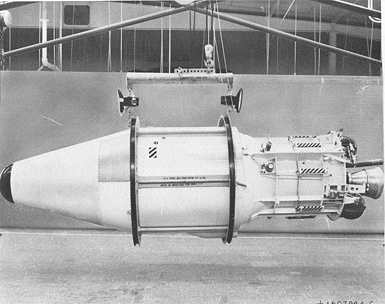
A USAF photo of
Discoverer-1.
|
The first Discoverer launch attempt that took place at
Vandenberg Air Force base in California on 21 January 1959 failed because of the
launch vehicle. The second launch took place on 28 February 1959. Initially the
satellite was reported to be in orbit, but I have always wondered what really
happened. It seems that contact was lost with the spacecraft very early in the
mission. In Swedish media the satellite was called "the whispering satellite".
Even the Swedish radio telescope at
Råö on the Onsala peninsula outside Gothenburg was reported to have picked
up weak signals.
I asked Dwayne Day, the foremost expert on the
U.S. reconnaissance satellite effort, about this mystery and here is his
reply:
"The person I talked to
was Frank Buzard ("buz ard") who was the test officer for Discoverer. He
was assigned to write up the reports on the launches after they were
over. Of course, Discoverer failed repeatedly for the first dozen
missions or so (although a few reached orbit). Buzard has a very good
memory and remembers what specifically went wrong with most of the early
missions. In the case of Discoverer 1, I think that the Air Force launched it
and they had no bad telemetry during the launch, but the telemetry did not
follow the entire Agena burn. Based upon something like 50% of the Agena
data being good, the Air Force assumed that the other 50% must be good and it
reached orbit. So they issued a press release saying it had reached orbit.
'Well that's a bad
assumption,' Buzard told me, and said that he did not like to assume anything
as far as rockets were concerned. So the Air Force said it was in orbit
and then everybody listened to hear it fly overhead. At the time, the
idea of getting a radar skin paint on a satellite was still pretty much
nonexistent. They relied upon picking up the radio beacon. But
nobody got a good beep beep beep. They had one or two stations that claimed
that they got a couple of beeps, but nothing more substantial.
I think that Buzard
looked at some data printouts and tried hard to interpret some spikes out of
the background noise as a signal from the satellite. He then turned this
into a report saying what the Air Force wanted him to say, but he was never
happy with it. And nobody else ever got good beeps from the satellite. Later,
after Discoverer was clearly successful (more than any of the public realized
at the time), those involved were willing to concede that they had probably
bent the data to serve public relations purposes .."
The flight of
Discoverer-2
Discoverer-2 was launched from Vandenberg Air Force
base at at 2122 UT on 28 February 1959. It entered an orbit between 239
and 346 km at an inclination of 89.9 degrees, a truly polar orbit -
very rare in the history of space flight (2). It was widely reported
as having come down on Svalbard and this event has even stimulated the Alistair
MacLean's novel "Ice Station Zebra" (1963) and the movie with the same name
(1968). The capsule was never found and the fate of the mission remains somewhat
of a mystery.
An internal CIA publication describes this flight as
follows(3):
"... The [U.S.] Air Force reported on 15 April that
plans to recover the capsule near Hawaii had been abandoned and that the
capsule might descend somewhere in the Arctic. The announcement slightly
understated the known facts. The capsule had ejected in the 17th orbit as
planned, but a programming malfunction (actually a human programming
error) had caused the ejection sequence to be initiated too early. The
capsule was down, probably somewhere in the near vicinity of the Spitsbergen
islands north of Norway. In fact, there were later reports that the falling
capsule had actually been seen by Spitsbergen residents. The Air Force
announced on the 16th that the Norwegian government had authorized a search
for the capsule which would begin the following day. Planes scoured the area,
and helicopters joined the search on the 20th. Nothing was found, however, and
the search was abandoned on the 23rd. [two lines deleted by censors] ..."
There
were many reports and rumors that the capsule had been recovered by Soviet
authorities using staff based at Soviet mining sites at Spitsbergen. However as(4) recounts
"... Not everyone was convinced that the capsule had
been recovered. Major Buzard initially felt that the capsule had come down on
Spitsbergen, but later changed his mind and suggested that the vehicle
probably came down in the water and sank, or never came down at all, suffering
the same fate as later satellites that had problems with their retro-rocket
de-spin system. There was no evidence on the ground that Discoverer-2
had been recovered. 'Witnesses' had been told exactly what to look for and may
have merely repeated what they were told ..."
Dwayne
Day has written an excellent
account
of
the flight of Discoverer-2 and the attempts to recover it.
As one can see from the plot below,
which shows the groundtrack for the climb out of Vandenberg on 13 April and
the planned recovery orbit on 14 April (landing would have occurred on the 15th,
Universal Time), the ground track of Discoverer-2 indeed passed over Spitsbergen,
and also straight over my home town - Stockholm, Sweden!
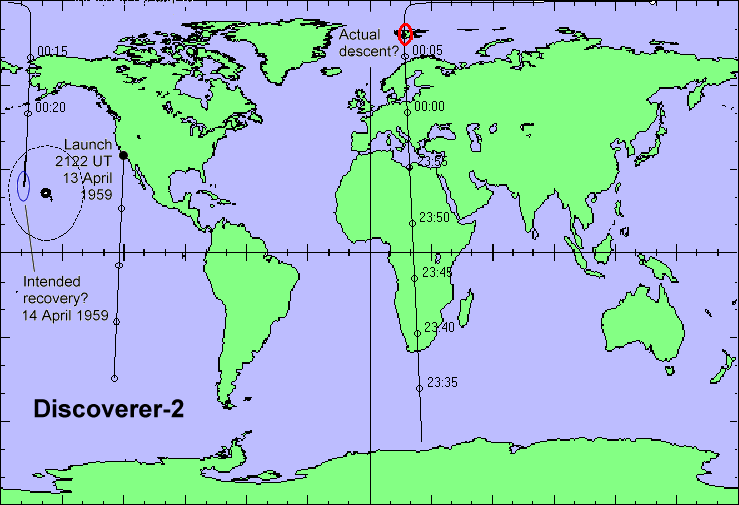
Discoverer-13, the first recovery from
orbit
Flight profile
Discoverer-13 was launched in a fog
bank from Vandenberg AFB at 2038 UT on 10 August 1960 and entered an orbit
between 253.5 and 690 km at 82.85 degrees inclination. At 2115 UT (5) on 11 August the
recovery sequence was initiated when the spacecraft was over the "Indian Ocean
Station" in the Seychelles. The station at Kodiak island transmitted the capsule
ejection command at 2311 UT on orders from the USAF Satellite Test
Control Center at Sunnyvale, California - "The Blue Cube". The parachute
opened at 2326 UT and the capsule descended about 480 km northwest of Hawaii.
The capsule was recovered at 0130 UT on 12 August 1960 200 km north-west
of Honolulu. A helicopter from Haiti Victory picked up the capsule.
The map below shows the ground trac for the launch out
of Vandenberg AFB on 10 August 1960 and the two last passes over the
Pacific the following day. The plots have been made with orbital element sets
from the old NASA OIG web site.
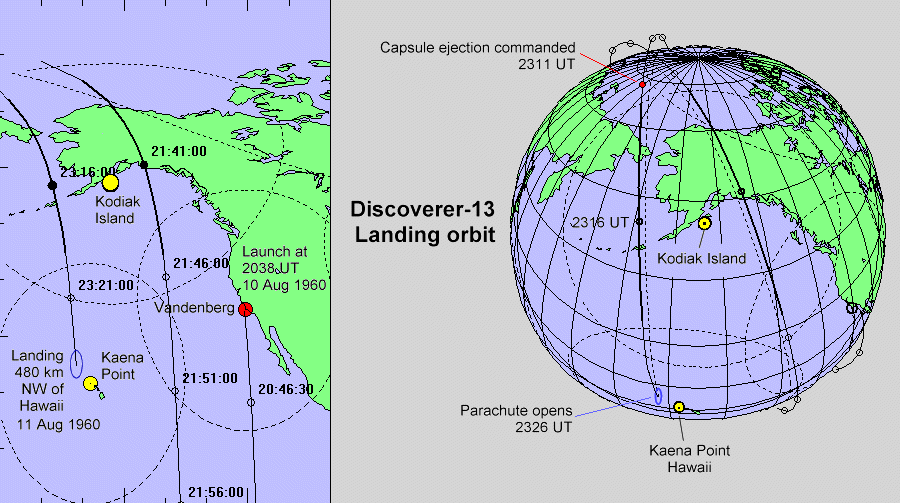
Dan Hill's eyewitness account
of the recovery of Discoverer-13
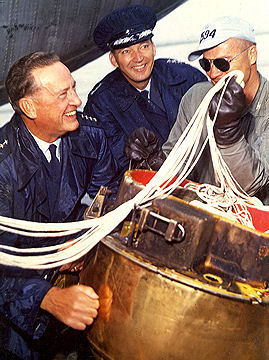
USAF Generals T.D. White (left) and Bernard
Schriever,
Col. Charles G. "Moose" Mathison,
and Discoverer-13 capsule. Note
beacon antenna
- see below. USAF
photo. |
In late
2009 I received a very interesting message from Dan Hill (9)
who participated in this historic event:
"... I was part of
the 6593rd Test Squadron "Special", which we had formed in the fall of 1958 at
Edwards AFB, CA., I occasionally search for any new data or input.
The purpose of our new squadron was to develop, test and practice aerial
recoveries of future space capsules. Our new Squadron relocated to
Hickam AFB, Hawaii, in early December 1958, and we continued practice
missions.
Our aircrew was very
close to Discoverer 13 space capsule when it re-entered Earth right on target
on August 11, 1960. We were prime recovery position, but unfortunately
we were directed away from the capsule by one of the control aircraft and by
the time our navigator realized they had sent us in the opposite direction, it
was too late.
He altered our course,
we flew back to where we should have been all along, and found the capsule and
parachute floating in the ocean. By that time another one of our
recovery aircrews were flying over the area as well. We dropped dye
markers and smoke bombs and flew surveillance for several hours till the U.S.
Navy got there and retrieved the historical capsule and chute into a
helicopter and flew them back to their ship
..."
Discoverer-14, the first aerial recovery
A mere
eight days after the launch of Discoverer-13 the next satellite is launched.
Thus, Discoverer-14 was launched from Vandenberg AFB at 1957 UT on 18 August
1960. The film capsule from Discoverer-14 was snagged by a n airplane over the
Pacific at 2314 UT on 19 August 1960. In 1999 Bill Obenauf wrote to me
(6)
about Disoverer-14:
"I
worked on Corona at Vandenberg 1959 - 1967. Your pictures are very familar. In
my desk drawer, under this keyboard, is a bolt from Discoverer 14, the first
capsule that brought back film. Thanks for bringing back many
memories."
|
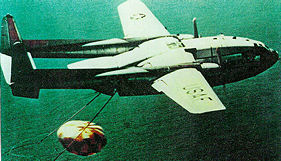
Snagging a capsule with a C-119 plane. This
picture
shows a practice run. USAF
photo
|
Dan Hill wrote to me
in 2009 (9) and described the recovery of
Discoverer-14 and his part in
it:
"... The following week, our aircrew was way, way down
range in the outfield of the recovery area, the least desirable recovery
position for Discoverer-14. As we all waited and waited, our navigator
finally received a signal, which became stronger. He directed our
aircrew to the signal, we scanned the skies overhead and finally our aircraft
commander saw the orange/silver parachute and capsule high above us. As
you know, history was in the making again, when on our third and last possible
aerial recovery attempt, we snagged the parachute with capsule attached [at
2600 meters altitude (11)
], had it in tow
and our winch operator brought them to the rear of our aircraft. At that
point, we Loadmasters lifted and pulled the first historical aerial recovered
chute and space capsule on board our now famous aircraft.
I just turned 21
years old (the youngest of our aircrew), the day that Discoverer-14 lifted off
and when we returned to Hickam AFB the next afternoon on August 19, 1960 with
the capsule, I was advised by our wing commander in front of the spectators
and press people as I was presented a birthday cake: 'Danny, yesterday they
sent your birthday present into orbit and today it was delivered to
you'. We were naturally, very proud of our historical catch, but
the fact that now, Discoverer-14 space capsule had been officially designated
my birthday present and my picture with me and cake went out to various parts
of the world. That made me that much prouder ..."

Newspaper clipping showing Dan
Hill receiving his
birthday
cake. |
The primary recovery area
encompassed a 320 x 96 km rectangle, and six C-119's and a C-130 flew within
this "ballpark" area. Three other C-119's, including the actual recovery
aircraft, patrolled an "outfield" area embracing an additional 640 km. the
capsule was hauled aboard the aircraft 30 minutes from the time the navigator
had first reported a steady signal from the capsule's radio beacon (11).
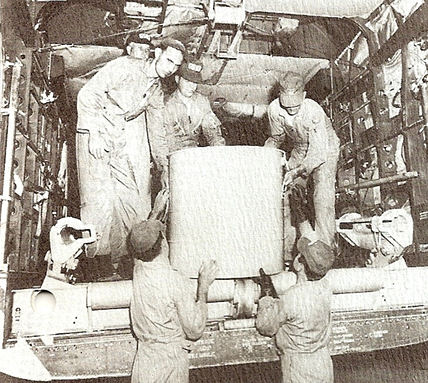
Air crew of C-119 (tail nr 18037) unload the
canister with the Discoverer-14
capsule inside. Dan Hill is the
righthand person standing on the ground. |
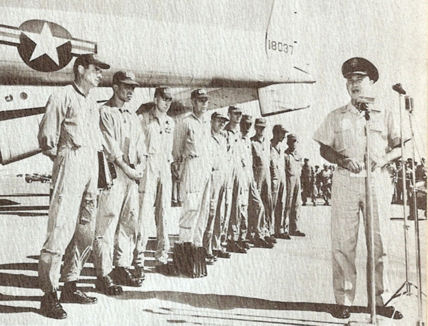
Discoverer-14 recovery crew and its
commander Captain Harold E Mitchell
being praised by Pacific
Air Force Commander General Emmett O'Donnell.
The stand in front of their
C-119 with tail number 18037. This plane is pre-
served.
Dan Hill is at the far right of
the line of airman. USAF
photo. |
Discoverer telemetry, command, and tracking systems
Telemetry and command system
|
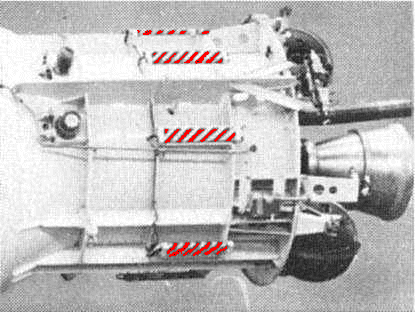
Telemetry antennas on an Agena-A. USAF photo.
|
The
Agena stage/spacecraft used an FM/FM telemetry system initially operating
on P-band (215-260 MHz) in the VHF range, called "Type V" (1). Orbital
determination and command reception was provided by an S-band beacon
transponder.
The telemetry system relayed 85 data
points(1)
.
Bill Obenauf, who worked
for Lockheed at Vandenberg Air Force Base, gave more details about the early telemetry system
of Corona (10):
"The Agena telemetry was FM/FM during the first few years.
It used 17 channels of sub-carrier oscillators modulating an FM transmitter. A
few of the oscillators were commutated using 60 point motor driven 'switches'.
Some oscillators monitored film rollers in the camera. One of the commutator
points monitored film quantity in the capsule."
Bill
Obenauf also described the command link (10)
:
"Commands were sent up from tracking stations to the
Agena via the S-band link to the tracking beacon. Two pulses, ten microseconds
spacing, were decoded by the agena beacon to generate a reply to the ground
tracking radar station. A third pulse, between the other two, was modulated
position-wise at audio rates to generate commands to the Agena. S-band was 10
cm [SG: 3 GHz]."
In (1) the Philco radar transponder
is said to have responded to a combination of two audio tones of the middle
pulse. Fifteen commands
from the decoder were possible by using
six audio frequencies in all possible combinations of two.
There was a
mechanical sequencer for executing commands out of sight of grund stations. It
had two magazines of punched Mylar tape. The programmer could execute twenty-six
commands repeatedly for 256 orbits. There was also a programmer for 52
preprogrammed commands and a flight loadable storage register for 32 commands(1)
. In addition to the main command
system there was also a UHF back-up command system.
Telemetry and recovery beacon
frequency
We can
learn something about the frequencies used for the VHF telemetry system by
referring to observations made by radio trackers at the time, and "leaks" in the
literature. The telemetry frequencies used were in P-band and the most common
telemetry frequency during early flights was 237.8 MHz. It is not easy to locate
antennas for this frequency band on pictures of Agena vehicles. Only in a
picture of what purportedly is Discoverer-1 can a ring of antennas be seen
around the engine compartment of the Agena rocket stage which formed part of the
spacecraft. These antennas seen in the picture (the stripes on the antennas
coloured red in the picture) below are probably so-called quadra-loop antennas
and the size is compatible with frequencies in P-band.
Bill Obenauf also wrote:
"... I asked a friend, who also worked on
Corona. After thinking about the Agena telemetry radio carrier frequency
238 MHz comes to mind Anyhow, the Corona capsule beacon used a carrier
of 235 Megacycles (we didn't use mega hertz in those days). It was
amplitude modulated by a tone that sounded like weep - weep - weep. The
period of the "weep" varied depending on events that happened during the
recovery, like parachute deploy
..."
We can also get
a glimpse of what the Agena telemetry sounded like by listening
to Agena signals on P-band picked up by satellite trackers at the University of Florida Student
Tracking Station in the 60's while they monitored telemetry from Agena target
vehicles for the Gemini program.
Radar transponder
|
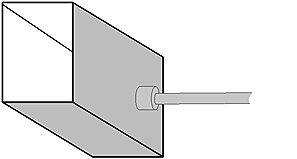
Waveguide antenna seen on an Agena stage on display
at
the National Air and Space Museum in Washington
D.C. |
Gemini-Agena had two radar transponders, one with a
downlink in S-band at 2910 MHz and another in C-band with a downlink at 5765
MHz. A few years ago, there was an Agena on display at the National Air and
Space Museum in Washington D.C. It carried device that looked like the sketch on
the right. The size and general look of this device suggest that it is a
waveguide antenna for C-band, possibly the radar transponder frequency 5765 MHz.
Ground station
operations
On a listserver, I cannot recall which, I found the
following personal memory from someone working at USAF tracking stations in the
early 60's (7)
:
"... I worked at several of the Air Force tracking
stations for these things including Vandenberg AFB in the early 60's. The
satellite command officer, or civilian was told what commands to send after we
turned the bird on. Any indications they got from the consoles was minimal and
certainly didn't let you know about film. It would be a reading, like: meter
number 5 reads 50 percent.
For
each 'pass' we set up the decommutator outputs to drive specific meters. We
had no idea what these meters were reading, but in real time we gave out those
numbers. So the sequence would be:'KODI Transmit command 1020'. Satellite
turns on-telemetry, decommutators lock onto the downlink, signal-meters start
to act. During the short pass we give the satellite command console operator
the read-outs. The console operator passes them to the 'Blue Cube'. He
then checks what is required and then sends back a response; 'Indi, send
command 2050, command 1010 and command 1230.' ...
...
The console operator then dials up those commands, they are picked from a
library of commands back in the computer room running a SperryRand computer,
and then he presses transmit. He then tells Palo Alto the commands he sent.
The only site that sent deorbit commands was the KODI site at Kodiak,
Alaska. The satellite would be heading south toward Hawaii the pickup
area ..."
Antennas on the
re-entry vehicle
The eleventh International Astronautical Congress (IAC) was
held in Stockholm in August 1960 as I have described in another article at
this web site. As you can read there a very detailed mock-up (actually a
"mechanical analog") of the Discoverer re-entry vehicle (including retro-rocket)
and film capsule was on display at the Congress and I (at the age of fourteen)
was given the task of describing it to the general public during "open day" on
the Congress' last day (see picture below), actually some fourty hours after
that the capsule from Discoverer-14 was snagged by a a C-119
plane.
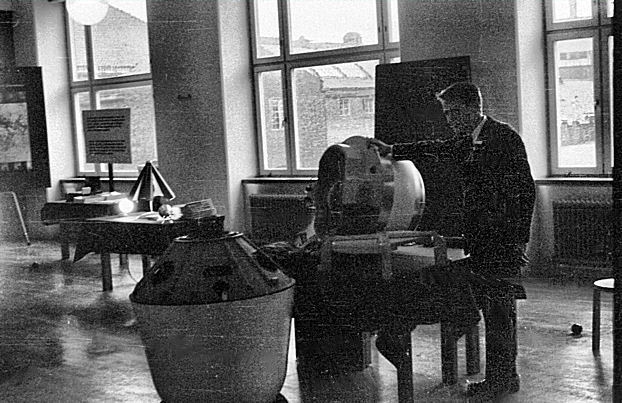
I hold my hand on
the Discoverer film capsule on display at the eleventh International
Astronautical
Congress. The venue is the Royal Institute of
Technology in Stockholm. The date is 21 August 1960. I
have
struggled to bring myself out of the horribly bad contrast of this picture. |
I also took some close-up pictures of the display. The
picture below shows the heat shield with the retro-rocket ona sheet metal cone
on the lower left and part of the film capsule on the upper
right.
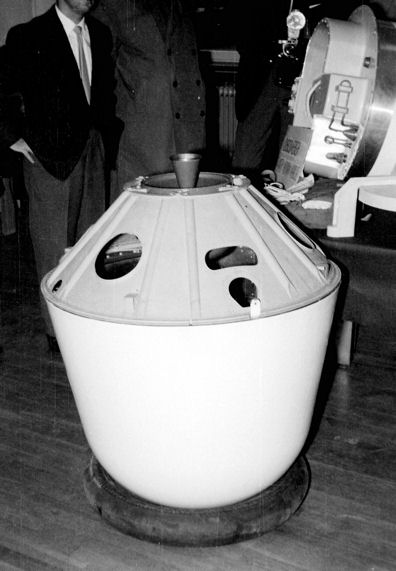
Discoverer heat shield with
retro-rocket on top and film capsule (upper
right) on display at IAC
1960 in Stockholm. |
By blowing up the little part of this picture that shows
the film capsule and turning it 90 degrees we can examine some deails on top of
the capsule.
|
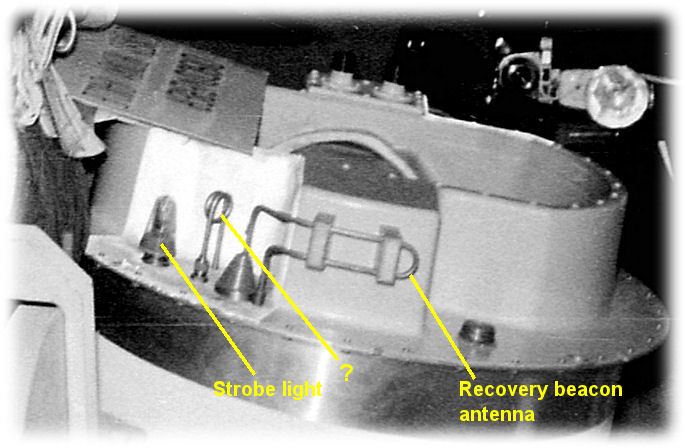
Details on top of the
Discoverer film capsule on display at the IAC 1960 in
Stockholm.
|
I can state with certainty
that device on the left is a strobe light and the device on the right looks like
a typical loop antenna half a wavelength long (see this article) with
one end grounded in the capsule chassis and the other end insulated from chassis
and fed by a transmitter. The size matches relatively well the beacon frequency
235 MHz. But what is the device marked "?"? It looks like an antenna too
with one end grounded and the other fed by a radio device. But what is the
frequency and purpose? Could it for a frequency in the range 1-2 GHz and is it a
radar transponder antenna? Interestingly this device can not be found on
pictures of the recovered Discoverer-13 capsule. On one side of this capsule one
can see the strobe light an a hole where "?" is seen above. On the other side of
the capsule there is no strobe light either, just a hole. The "?" can be seen in
a picture by James Plummer.
Re-entry
and recovery sequence
In
(11) Some basic numbers are
given:
-
The reto-rocket impulse is
directed backwards 60 degrees below the local horixontal.
-
Re-entry vehicle size and
mass:
-
Heat shield length 686
mm, diameter <= 838 mm
-
Retrorocket cone length
approx 330 mm
-
Total re-entry vehicle
length approx 1016 mm
-
Approximate mass 160
kg
-
Radio blackout ended at
40.5 km
-
Parachute deployed at 15-16.5 km altitude. This is
very high and probably intended to provide a long descent time so that the
aircraft on patrol would have a chance to reach the capsule
for snagging. According to (1) the rate of descent varied
between 15 m/s and 6 m/s and the total time of descent from 15 km was about 30
minutes.
-
Distance from retrofire to
recovery was about 3200 km.
-
The recoverable film
capsule weighed approx 38 kg
Orbital parameters of
early Discoverer missions
The obital elements of early Discoverer satellites were similar between flights,
but not identical. To able to find a pattern
I plotted the mean motion (revolutions/day) against the inclination
for the first 39 launches that made it to orbit. (See the figure
below) The inclination varied less than the mean motion. It seems that the
orbital period (together with the inclination) was used to achieve coverage
of differenet areas. To prove this and extenisve study of the coverage over the
Soviet Union of each of these missions. I am not sure the photo coverage of all
these missions have been made public.
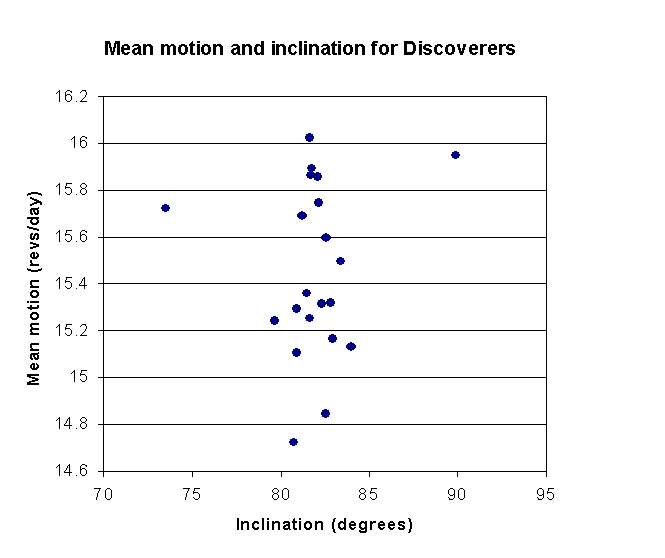
References
-
Robert A. McDonald (ed.),
"Corona, Between the Sun & the Earth, The first NRO reconnaissance Eye
in the Sky", American Society for Photogrammetry and Remote Sensing,
Bethesda, MD, 1997.
-
D.G. King-Hele et al, "The RAE Table of Earth Satellites",
1957-1989", Royal Aerospace Establishment, 1990.
-
Kenneth E. Greer, "Corona", Studies in Intelligence,
Supplement, 17 (Spring 1973): 1-37. Reprinted in "Corona: America's first
Satellite program", Kevin C. Ruffner (ed) , CIA, 1995.
-
Dwayne Day et al, "Eye in the Sky", Smithsonian
Institution Press, 1998 p.53.
-
Booda, "First Capsule";
Witkin, "Washington to Hail"; Office of the Director of Defense Research
and Engineering, Military Space Projects No. 11, p.3. (Reference
given in Jeffrey T. Richelson, "America's Secret Eyes In Space",Harper &
Row, 1990)
- E-mail from Bill Obenauf on 6 March 1999.
-
If someone recalls that he sent this message, please let
me know!
- Relayed to me by Volker Baumann
- E-mail from Dan Hill, 30
December 2009.
- E-mail from Bill
Obenauf, 12 March 1999.
- "Summary.
US Air Force Discoverer satellite recovery vehicle program, I thru XIV",
General Electric Missiles and Space Vehicle Department Publication PIB-52,
1960.

 Back to Space History Notes
Back to Space History Notes













